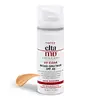What's inside
What's inside
 Key Ingredients
Key Ingredients

 Benefits
Benefits

 Concerns
Concerns

 Ingredients Side-by-side
Ingredients Side-by-side

Zinc Oxide 9%
Cosmetic ColorantEthylhexyl Methoxycinnamate 7.5%
UV AbsorberWater
Skin ConditioningCyclopentasiloxane
EmollientNiacinamide
SmoothingOctyldodecyl Neopentanoate
EmollientButylene Glycol
HumectantHydroxyethyl Acrylate/Sodium Acryloyldimethyl Taurate Copolymer
Emulsion StabilisingPolyisobutene
PEG-7 Trimethylolpropane Coconut Ether
EmulsifyingSodium Hyaluronate
HumectantTocopheryl Acetate
AntioxidantLactic Acid
BufferingOleth-3 Phosphate
Phenoxyethanol
PreservativeIodopropynyl Butylcarbamate
PreservativeIsopropyl Palmitate
EmollientEthylhexyl Stearate
EmollientIron Oxides
Triethoxycaprylylsilane
Zinc Oxide 9%, Ethylhexyl Methoxycinnamate 7.5%, Water, Cyclopentasiloxane, Niacinamide, Octyldodecyl Neopentanoate, Butylene Glycol, Hydroxyethyl Acrylate/Sodium Acryloyldimethyl Taurate Copolymer, Polyisobutene, PEG-7 Trimethylolpropane Coconut Ether, Sodium Hyaluronate, Tocopheryl Acetate, Lactic Acid, Oleth-3 Phosphate, Phenoxyethanol, Iodopropynyl Butylcarbamate, Isopropyl Palmitate, Ethylhexyl Stearate, Iron Oxides, Triethoxycaprylylsilane
Water
Skin ConditioningDibutyl Adipate
EmollientDipropylene Glycol
HumectantCI 77891
Cosmetic ColorantGlycerin
HumectantIsononyl Isononanoate
EmollientCoco-Caprylate/Caprate
EmollientDiethylamino Hydroxybenzoyl Hexyl Benzoate
UV FilterNiacinamide
SmoothingPolymethylsilsesquioxane
1,2-Hexanediol
Skin ConditioningSedum Sarmentosum Extract
HumectantAnastatica Hierochuntica Extract
AstringentHydrolyzed Hyaluronic Acid
HumectantSqualane
EmollientTocopherol
AntioxidantButylene Glycol
HumectantBis-Ethylhexyloxyphenol Methoxyphenyl Triazine
Skin ConditioningEthylhexyl Triazone
UV AbsorberPentylene Glycol
Skin ConditioningPolysilicone-15
UV FilterSilica
AbrasiveTerephthalylidene Dicamphor Sulfonic Acid
UV AbsorberPolyhydroxystearic Acid
EmulsifyingPolyglyceryl-3 Distearate
EmulsifyingSodium Polyacryloyldimethyl Taurate
Emulsion StabilisingPotassium Cetyl Phosphate
EmulsifyingTromethamine
BufferingIsododecane
EmollientOctyldodecanol
EmollientAluminum Hydroxide
EmollientStearic Acid
CleansingPolyacrylate Crosspolymer-6
Emulsion StabilisingAmmonium Polyacryloyldimethyl Taurate
Emulsion StabilisingPolyglyceryl-4 Isostearate
EmulsifyingIsopropyl Titanium Triisostearate
EmollientPolyglyceryl-2 Dipolyhydroxystearate
Skin ConditioningHydroxypropyl Methylcellulose Stearoxy Ether
Ethylhexylglycerin
Skin ConditioningSodium Polyacrylate
AbsorbentGlyceryl Stearate Citrate
EmollientAdenosine
Skin ConditioningBehenyl Alcohol
EmollientDisodium EDTA
CI 77492
Cosmetic ColorantCI 77491
Cosmetic ColorantWater, Dibutyl Adipate, Dipropylene Glycol, CI 77891, Glycerin, Isononyl Isononanoate, Coco-Caprylate/Caprate, Diethylamino Hydroxybenzoyl Hexyl Benzoate, Niacinamide, Polymethylsilsesquioxane, 1,2-Hexanediol, Sedum Sarmentosum Extract, Anastatica Hierochuntica Extract, Hydrolyzed Hyaluronic Acid, Squalane, Tocopherol, Butylene Glycol, Bis-Ethylhexyloxyphenol Methoxyphenyl Triazine, Ethylhexyl Triazone, Pentylene Glycol, Polysilicone-15, Silica, Terephthalylidene Dicamphor Sulfonic Acid, Polyhydroxystearic Acid, Polyglyceryl-3 Distearate, Sodium Polyacryloyldimethyl Taurate, Potassium Cetyl Phosphate, Tromethamine, Isododecane, Octyldodecanol, Aluminum Hydroxide, Stearic Acid, Polyacrylate Crosspolymer-6, Ammonium Polyacryloyldimethyl Taurate, Polyglyceryl-4 Isostearate, Isopropyl Titanium Triisostearate, Polyglyceryl-2 Dipolyhydroxystearate, Hydroxypropyl Methylcellulose Stearoxy Ether, Ethylhexylglycerin, Sodium Polyacrylate, Glyceryl Stearate Citrate, Adenosine, Behenyl Alcohol, Disodium EDTA, CI 77492, CI 77491
 Reviews
Reviews

Ingredients Explained
These ingredients are found in both products.
Ingredients higher up in an ingredient list are typically present in a larger amount.
Butylene Glycol (or BG) is used within cosmetic products for a few different reasons:
Overall, Butylene Glycol is a safe and well-rounded ingredient that works well with other ingredients.
Though this ingredient works well with most skin types, some people with sensitive skin may experience a reaction such as allergic rashes, closed comedones, or itchiness.
Learn more about Butylene GlycolNiacinamide is a multitasking form of vitamin B3 that strengthens the skin barrier, reduces pores and dark spots, regulates oil, and improves signs of aging.
And the best part? It's gentle and well-tolerated by most skin types, including sensitive and reactive skin.
You might have heard of "niacin flush", or the reddening of skin that causes itchiness. Niacinamide has not been found to cause this.
In very rare cases, some individuals may not be able to tolerate niacinamide at all or experience an allergic reaction to it.
If you are experiencing flaking, irritation, and dryness with this ingredient, be sure to double check all your products as this ingredient can be found in all categories of skincare.
When incorporating niacinamide into your routine, look out for concentration amounts. Typically, 5% niacinamide provides benefits such as fading dark spots. However, if you have sensitive skin, it is better to begin with a smaller concentration.
When you apply niacinamide to your skin, your body converts it into nicotinamide adenine dinucleotide (NAD). NAD is an essential coenzyme that is already found in your cells as "fuel" and powers countless biological processes.
In your skin, NAD helps repair cell damage, produce new healthy cells, support collagen production, strengthen the skin barrier, and fight environmental stressors (like UV and pollution).
Our natural NAD levels start to decline with age, leading to slower skin repair, visible aging, and a weaker skin barrier. By providing your skin niacinamide, you're recharging your skin's NAD levels. This leads to stronger, healthier, and younger looking skin.
Another name for vitamin B3 is nicotinamide. This vitamin is water-soluble and our bodies don't store it. We obtain Vitamin B3 from either food or skincare. Meat, fish, wheat, yeast, and leafy greens contain vitamin B3.
The type of niacinamide used in skincare is synthetically created.
Learn more about NiacinamideWater. It's the most common cosmetic ingredient of all. You'll usually see it at the top of ingredient lists, meaning that it makes up the largest part of the product.
So why is it so popular? Water most often acts as a solvent - this means that it helps dissolve other ingredients into the formulation.
You'll also recognize water as that liquid we all need to stay alive. If you see this, drink a glass of water. Stay hydrated!
Learn more about Water